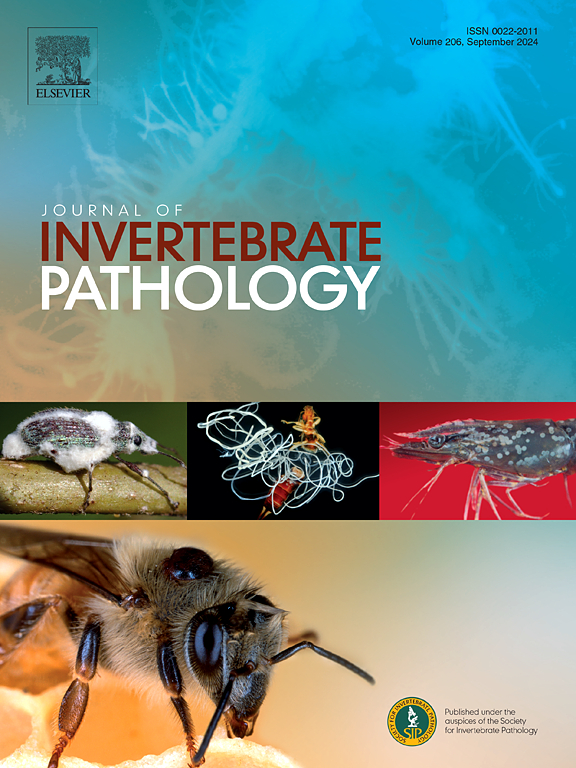Fungal-bacterial interactions leading to increased insect mortality: Trichoderma xixiacum enhances the pathogenicity of Serratia marcescens in Protaetia brevitarsis larvae
IF 3.6
3区 生物学
Q1 ZOOLOGY
引用次数: 0
Abstract
Edible insect farming presents significant potential as a sustainable solution to meet the increasing demand for protein and biowaste recycling. However, microbial contamination in rearing substrates poses a serious threat to insect populations. This study investigates the pathogenicity of Serratia marcescens YSMM-S1, isolated from dead Protaetia brevitarsis larvae, and explores its interaction with Trichoderma xixiacum, a fungus co-isolated from the same rearing environment. The identified S. marcescens YSMM-S1 was confirmed as a highly virulent strain, causing 100 % larval mortality within 24 h. In addition, T. xixiacum identified via extensive molecular and morphological characterization, is reported here for the first time in Korea. Co-cultivation and mycophagy assays revealed a significant increase in S. marcescens proliferation in the presence of T. xixiacum, likely through fungal mycelium consumption. Moreover, preinoculation with T. xixiacum in oak-fermented sawdust significantly enhanced S. marcescens population growth and colonization. In vivo assays further demonstrated that co-inoculation of the substrate with both microorganisms resulted in significantly higher larval mortality compared to single inoculations. This study provides novel insights into the complex microbial dynamics in insect-rearing systems, emphasizing the role of T. xixiacum in facilitating bacterial pathogenicity. The findings highlight the need for careful microbial management to prevent outbreaks in mass-rearing environments. This work also contributes to the understanding of fungal-bacterial interactions in insect farming and offers new perspectives on the ecological roles of Trichoderma species in rearing substrates.

真菌与细菌的相互作用导致昆虫死亡率增加:西霞木霉增强了短维弧菌幼虫中粘质沙雷氏菌的致病性
食用昆虫养殖作为一种可持续的解决方案,具有巨大的潜力,可以满足日益增长的对蛋白质和生物废物回收的需求。然而,养殖基质中的微生物污染对昆虫种群构成了严重威胁。本研究研究了从短白原菌(Protaetia brevitarsis)死亡幼虫中分离到的粘质沙雷氏菌YSMM-S1的致病性,并探讨了其与在相同饲养环境中分离到的西峡木霉(Trichoderma xixiacum)的相互作用。鉴定出的粘质葡萄球菌YSMM-S1为高毒力菌株,24 h内幼虫死亡率100%。此外,通过广泛的分子和形态鉴定鉴定出的西xixiacum在国内尚属首次报道。共同培养和真菌吞噬实验显示,在T. xixiacum存在的情况下,粘质葡萄球菌的增殖显著增加,可能是通过真菌菌丝的消耗。此外,在橡木发酵木屑中预接种西xixiacum可显著促进粘质葡萄球菌种群的生长和定植。体内实验进一步证明,与单独接种相比,两种微生物共同接种底物可显著提高幼虫死亡率。该研究为昆虫饲养系统中复杂的微生物动力学提供了新的见解,强调了T. xixiacum在促进细菌致病性中的作用。这一发现强调了在大规模饲养环境中对微生物进行仔细管理以防止暴发的必要性。这项工作也有助于了解昆虫养殖中真菌与细菌的相互作用,并为木霉物种在饲养基质中的生态作用提供了新的视角。
本文章由计算机程序翻译,如有差异,请以英文原文为准。
求助全文
约1分钟内获得全文
求助全文
来源期刊
CiteScore
6.10
自引率
5.90%
发文量
94
审稿时长
1 months
期刊介绍:
The Journal of Invertebrate Pathology presents original research articles and notes on the induction and pathogenesis of diseases of invertebrates, including the suppression of diseases in beneficial species, and the use of diseases in controlling undesirable species. In addition, the journal publishes the results of physiological, morphological, genetic, immunological and ecological studies as related to the etiologic agents of diseases of invertebrates.
The Journal of Invertebrate Pathology is the adopted journal of the Society for Invertebrate Pathology, and is available to SIP members at a special reduced price.

 求助内容:
求助内容: 应助结果提醒方式:
应助结果提醒方式:


